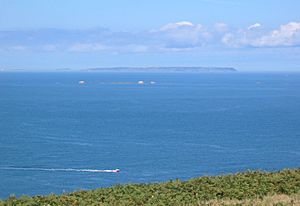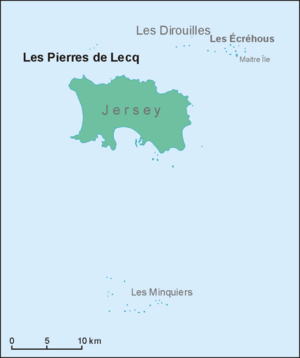Pierres de Lecq facts for kids
Quick facts for kids
Designations
|
|
| Official name: Les Pierres de Lecq | |
| Designated: | 2 February 2005 |
|---|---|
| Reference #: | 1457 |
Les Pierres de Lecq (Jèrriais: Les Pièrres dé Lé), also known as the Paternosters, are a group of rocks in the Bailiwick of Jersey. These rocks are not suitable for people to live on. They are located between the islands of Jersey and Sark. You can find them about 6 miles (6 km) north of Grève de Lecq in Saint Mary. They are also about 14 miles (22.4 km) west of the Cotentin Peninsula in Normandy, France.
At high tide, only three or four of these rocks can be seen above the water. These include L'Êtaîthe (the eastern one), La Grôsse (the big one), and La Vouêtaîthe (the western one). This area has one of the biggest changes between high and low tide in the world. The water level can change by as much as 39 feet (12 meters)!
The name Paternosters comes from an old story. It's linked to how the island of Sark was settled in the 1500s. The legend says that a boat carrying women and children crashed on these rocks. People say their cries can still be heard sometimes when the wind blows. Sailors who were superstitious would say the Lord's Prayer (which starts with "Pater Noster" in Latin) when they sailed past the rocks. This is how the name Paternosters came about.
A Special Ocean Place
The rocks of Les Pierres de Lecq are like a natural border in the ocean. They separate a colder part of the sea from a warmer part. This mix, along with the different types of rocks and how much waves hit them, creates many different places for sea creatures to live. This means there is a huge variety of life, also known as biodiversity, in this area.
Home for Sea Life
The many types of seaweeds found here support a wide range of animals without backbones, like crabs and starfish. This area also acts as a nursery for many kinds of fish. A nursery is a safe place where young fish can grow.
Important fish species that live here include the European sea sturgeon, the short-snouted seahorse, and the Atlantic salmon. The rocks are also a special protected area called a Ramsar site. This means they are important wetlands for wildlife. You can also find different types of small dolphins here.
Names of the Rocks
Each of the rocks in Les Pierres de Lecq has its own unique name. Many of these names are in Jèrriais, the local language of Jersey.
Here are some of the names of the rocks:
- L'Êtchièrviéthe
- La Rocque du Nord
- L'Êtaîse or L'Êtaîthe
- Lé Bel
- Lé Longis
- La P'tite Mathe
- La Grôsse (which means Great Rock)
- La Grand' Mathe
- La Greune dé Lé, or La Bonnette
- La Greune du Seur-Vouêt
- L'Orange
- La Vouêtaîse, La Vouêtaîthe, or La Vouêt'rêsse
- La Cappe
- La Douoche
- Lé Byi
- La Rocque Mollet
- L'Êtché au Nord-Vouêt
- La Galette
- La Briarde
- La Sprague
- La Niêthole Jean Jean or Lé Gouoillot
See also
 In Spanish: Les Pierres de Lecq para niños
In Spanish: Les Pierres de Lecq para niños



